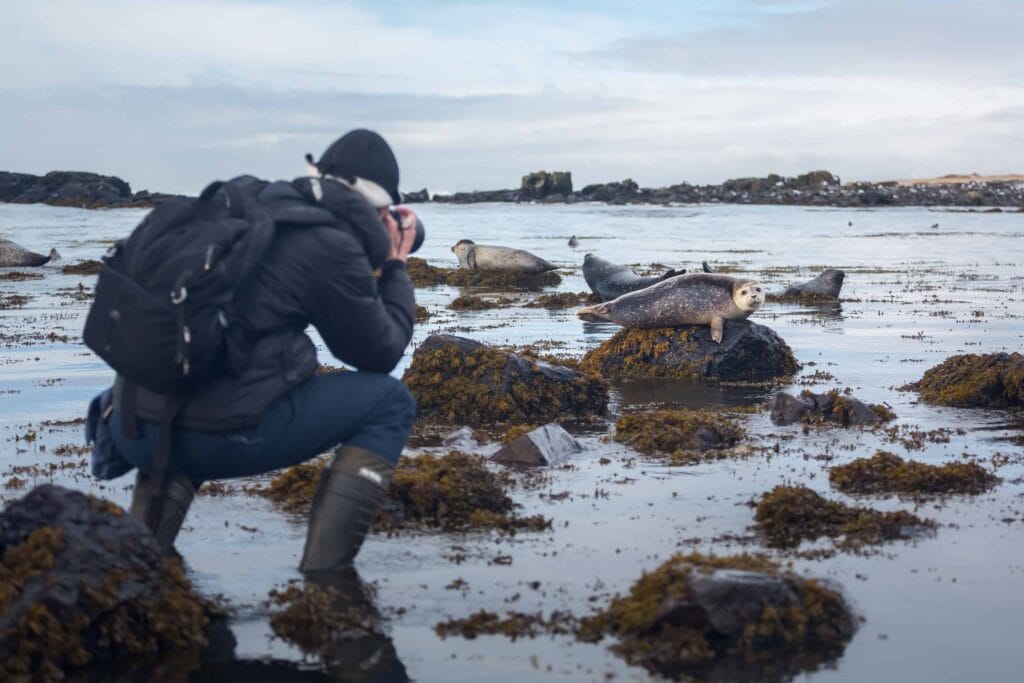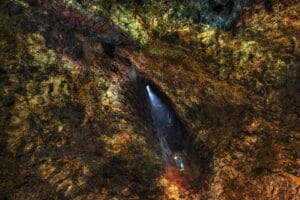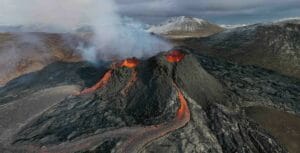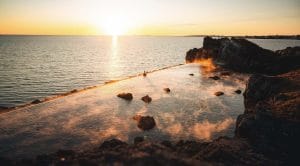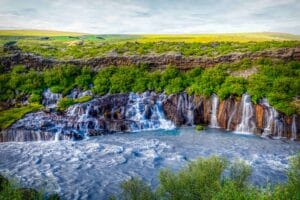It is about time that you prevent your DSLR from rusting in the cupboard and step into the wilderness, taking scenic pictures of the landscapes in Iceland. The country is famous among photographers both amateur and professional for its unparalleled beauty and contrasting landscapes. Imagine, being able to capture the majestic northern lights and the awe-inspiring waterfall cascades.
The dynamic weather conditions make the country worth taking mesmerizing snapshots of. You get an opportunity to capture a landscape beneath the dark sky and the next moment you have the basking sun, warming the scenery. Photography in Iceland is largely dependent on seasonal changes. This is a guide to what and why it is worth clicking in Iceland.

Iceland: Home to Picturesque Views
A north-western European island, Iceland is indeed an abode with varying topographies such as mountains, volcanoes, glaciers, and black sand beaches. It is a blend of four basic elements of nature – fire, air, earth, and water. The Iceland has recently risen to fame as one of the best holiday destination in the world. Over 2 million tourists visit the island to soak in the awe-inspiring landscape. The vibrant culture, amusing festivals, and colorful fauna and flora will surely motivate you to go for an Iceland photography tour. You get an opportunity to capture photos of some of the wildlife distinctive only to the country.
Most of the photography is highly influenced by the seasons in Iceland. In winter, the sun is up only for a few hours making the daylight golden and picture-worthy. While in the warmer months, the sun never sets, allowing you to click the bright horizon. Between the seasons, the features of the natures appear different. In fact, the changes in nature are more dramatic in Iceland than in most of the other countries. So, when traveling across the country in the summers, you could visit Mt. Kirkjufell, a photography hotspot, under the bright summer skies and spend hours capturing the midnight sun. Visiting Kirkjufell in winters gives you a great chance of capturing the northern lights and bright starts above dance above the mountain.

Photography in Iceland 101
Here are some photography ideas and the ideal places to get them that you can try when on the island. Mind that there is hardly any place in Iceland where you cannot get quality photographs so no matter what, always be camera-ready when you step out of your hotel room. Most people that travel to Iceland, want to stop every 5 minute to take a photo of something that they see out of their car window. However, this is not possible if you are traveling for example the Ring Road around the country. So you will soon realize that you have to choose the spots that you want to photograph very carefully. Let us now review the top places for every kind of photography in Iceland.
Landscape Photography
The dynamic topography offers an array of landscape photography options be its spectacular coastal views, mountain ranges, glaciers, lava fields, or geothermal landscapes. You can get some of the best images on the south coast, the Snaefellsness Peninsula, and around the Lake Myvatn area.
South Coast
When you leave Reykjavik and head to the south coast of Iceland, you first pass through the earthquake town of Hveragerdi where you can take pictures of geothermal landscapes. If you travel a little further along the east, you reach Seljalandsfoss and Skogafoss. You can capture the images of the charming cascade of the former and the force of the latter.
A little along the route you will pass the glaciers – Mydralsjokull and Eyjafjallajökull where you can catch glimpse of the volcanoes hidden beneath them. You can even make the dramatic features like the Dyrholaey rock arch and black sands of Reynisfjara beach as your next subjects. If you plan a photo tour along the South Coast, one of the best places is Skaftafell Nature Reserve.
Skaftafell is often detonated as ‘hiker’s paradise’ and is loved for its scenic trails, dramatic landmarks, and diverse scenery. What makes the place so picturesque is the varying topography – glacier tongues, lagoons, forests, lava fields, and enormous waterfalls. Some other attractions that are sure to lure your camera include Diamond Beach, Mt. Vestrahorn, Vatnajokull National Park, and the best spot – Jokulsarlon glacier lagoon. Seasons, too, help you get incredibly varying photos.
If someone plans to get a little more adventurous, one can take a detour to the region of Landmannalaugar between the months of June and August. There you can capture some breathtaking images of the Highlands, the country’s most remote region along with the Rhyolite Mountains and geothermal areas. To get better pictures along the South Coast you can also opt for self-drive tours.
Snæfellsnes Peninsula
Snæfellsnes Peninsula is often called Iceland in a miniature. This is because Snæfellsnes has everything that you can find in Iceland. From glaciers to beaches, lava fields, waterfalls, craters, ice and lava caves, bird and whale watching spots, gorgeous towns and villages with rich history and culture as well as huge basalt rock structures. Snæfellsnes Peninsula contains most types of attractions from all over the country. This makes it the perfect location for a photography trip.
When you start your drive along the peninsula you can make your first stop at the basalt columns of Gerðuberg. This unique rock formation is always worth capturing on your pictures. As you keep on driving along the peninsula you will reach the unique area of Búðir. The black church in Búðir has been popular among photographers in the recent years because of its contrast among the natural landscape all around it. Rauðfeldsgjá canyon and Arnarstapi are next in line on the photographers bucket list. Rauðfeldsgjá is a dark and deep ravine in the mountain so for amatures it can be very hard to take a good picture in there, but for those who are up for a challenge, you can get some great shots. Arnarstapi is beautiful and a must for every photographer. The arch cliff above the sea is one of the most popular photo stop in Iceland.
As you keep on driving around the peninsula, you will find Hellnar with its beautiful cliffs, views over the sea and the hidden caves. Djúpalónssandur black sand beach is another favorite among photographers as well as Snæfellsjokull glacier.
Soon you will reach Kirkjufell Mountain, one of the most photographed mountain in the world. This uniquely shaped mountain has been the main attraction among photographers when traveling to Iceland. The shape of the mountain appears to be triangular from a long distance it is rather wide from the top when it seems up close. This is a popular photography spot in all seasons. The midnight sun makes the mountain shine during summer while the northern lights dance beautifully around it during the winter time.
If you still have time, you might want to check out Berserkjahraun lava fields, and the fishing villages of Stykkishólmur and Grundarfjörður. There are also some more hidden waterfalls that will be on your way, like Selvallafoss, Svöðufoss and Bjarnarfoss. Svörtuloft and Lóndrangar are another destinations to add to your photography tour around Snæfellsnes Peninsula if you have the time.

Wildlife Photography
The country boasts diverse wildlife, some of which are specific to the region. Thus, you can get some reward-worthy photographs of the bird species, especially the migratory species like puffins flock that nest by the shore. The best part, these birds are unafraid of humans even if you go remarkably close to capturing their snaps. They definitely are some good models. So, if you wish to photograph the bird, it is recommended to use a telescopic lens for mesmerizing shots. It helps you capture even the minutest details of the bird including the expressive eyes and colorful beak.
Besides capturing the charming birds you can also take pictures of the species of whale and dolphin that the country homes. The town of Husavik is the most preferred spot for whale watching and capturing breathtaking pictures of the giant mammals. You can even take whale-watching tours from Akureyri, Reykjavik, and Snaefellsness Peninsula. The scenic surroundings of the ports often give an opportunity to view the dolphins and whale flukes. Another popular marine mammal worth capturing in the camera is SEAL. They can be found all around the country but majorly on the Vetnsnes Peninsula, on the Ytri Tunga beach on Snaefellsness and within the Jokulsarlon glacier lagoon. In the lagoon, you can capture them hauling out on the iceberg.
In Iceland, you can also find the native land animal Arctic Fox– a well-camouflaged and cautious creature. It is a great subject for experienced wildlife photographers. They are in abundance in Hornstrandir Nature Reserve in the north of Westfjords. This area is only accessible during summers. Iceland is a nation that relies heavily on agriculture and is home to several farm animals including sheep, cows, and horses. The best-domesticated animals here are indeed the Icelandic horses that are unique to the country.

Culture Photography
The culture of Iceland is drawing more attention every year. The culture here includes architecture, fests, and concerts. Within the capital city of Reykjavik, you can find some breathtaking iron houses and modern buildings such as the concert hall Harpa and the church Hallgriskirkja. Besides architectural photography, the island also offers the opportunity to capture the photographs of the work of art all across. There are many public sculptures. The Sun Voyager is a great piece of work that faces Mt. Esja over the Faxafloi Bay. It embodies the spirit of an adventurer when captured at sunrise or sunset.
The capital city is becoming a hub for street art. There are murals that were created as part of the Berlin-inspired Wall poetry movement. It depicts the vibrant and creative side of the city. Art photography is not limited just to Reykjavik. You can visit the Eggs of Merry Bay in the eastern village of Djupivogur. You can also see the Ring and Sphere work on Grimsey Islands. Even in the town of Akureyri, you can find some rich sculptures on display.

Capturing the Northern Lights
Photographing nature is bliss in itself and capturing something as divine as aurora borealis takes the photography experience to the next level. The best time to try and capture this natural phenomenon begins from the end of August till the beginning of April, when there is enough darkness for capturing the Northern Lights in its glory.
Photographing northern lights is every photographer’s dream. Since everyone is equipped with a smartphone, it becomes difficult to capture the phenomenon in the best possible way. Thus, DSLR is the best camera to capture it. Ensure you carry your wide-angle lens to capture the broader perspective of the phenomenon. Using a tripod stand will prevent shaky pictures and fatigue. The tripod you carry should be lightweight and easy to move. Make sure it has a ball head that ensures its sturdiness.
Capturing the Midnight Sun
Iceland is the land of multiple possibilities. From June 16th to 29th the sun does not set in the country. This never-ending day stretches for over two months and proves to be an ideal time for photographing all day and all through the night. You can capture sites around the country in the birhgt summer nights with no tourists around. You can also take exquisite pictures of the Highlands which open only in June as the winters make the area dark and thus, it is blocked-off for photography. Photographing in the midnight sun is extraordinary since the lightning will be something that you have never seen before.

A perfect Photogenic Country
Iceland is one of the world’s greatest destinations in the world. The Nordic country is home to incredible landscapes, unique wildlife, a holistic culture, fascinating and friendly people, and diverse and dynamic lighting conditions. It is a country that hosts unparalleled phenomena, all of which are worth adding to your otherworldly portfolio. You can opt for different photography tours when in Iceland.
Photography essentials to bring with you on the trip to Iceland
- Tripod: It is necessary to carry a tripod to shoot long shutter speeds and produce sharp photos. Tripod is also a must when photographing the northern lights. The most recommended tripod is Sirui W2204 waterproof tripod with a K20x ball head. The ball head ensures a sturdy camera setting.
- Camera Backpack: A camera backpack will secure the camera in place. Go for a camera bag that is compartmentalized for filters and memory cards. It is convenient for outdoors photographers like you.
- Lens Cloth: Iceland is the land of waterfalls and thus there are chances of camera lens catching mist. You should hence always keep a lens cloth handy to dry the front of the lens.
- Photography Filters: Go for neutral density and graduated neutral density filters when planning the photography tour. They allow you to have more control over the shutter speeds. A circular polarizer is another filter worth using. It is suitable for removing glares from sun reflection in the water and adding contrast to your images.
Another important thing is to ensure that your camera is picture ready. Adjust the basic settings of the camera to get that picturesque view.
- Camera Focus: Keep the camera focus on infinity to get sharp pictures. Since focusing the camera would be difficult at night, it can be done in the daylight. You can set the focus, mark the space, and keep the tab that you are able to find it in the dark.
- Aperture: The best aperture setting for a setup like this could be between f/3.5 and f/4. Make sure you do not go any wider and lose focus.
- Exposure: When capturing the northern lights, the shutter speed should match the speed of the aurora. You can keep 20-25 seconds shutter speed for slow-moving northern light and 5-10 seconds for fast-moving one.
- ISO: Start with 1600 as this can work for medium-strength aurora. For capturing an intense northern lights action, you can use 800 ISO value. It is on you to decide the kind of ISO setting you want to capture the perfect natural phenomenon.
- White Balance: This setting will help you determine the kind of colors you want to capture.
The best places to capture the Northern Lights are – Grótta, Perlan, Vik Black Sand Beach, Seljavallalaug Pool, Threngsli, Thingvellir National Park, Gullfoss Waterfall, Gasir, Asbyrgi Canyon, Kirkjufell, Grenivik Village Hill, Stapavik Beach, Djupavik, and Hvitsekur.

When to visit
The highlights in the country completely depend upon the seasons. If you plan to capture the northern lights, anywhere between September to March is an ideal time. To capture the midnight sun, you can visit in the month of June when the sun never sets. Each season in the country has something unique to offer. If you are a photographer on a budget it is best to visit during spring and autumn as the accommodation rates are affordable and you can get a chance to admire the landscape in peace, with few people around.
Go for Professional tours
To fully immerse in the photography experience in Iceland, it is often recommended to take a photo tour or workshop. You can range some sites within a day while others may require some extra time. These tours are educational experiences and are often conducted by the nation’s reputed landscape photographers. The best part about these tours is that the experts help you with the photography technique and predicting the right time for clicking a picture.
Get Your Homework done
The seasons in Iceland are extreme. Therefore, you should prepare accordingly. To survive the winters, you should pack scarves, mufflers, gloves, boots, warm clothes, insulated jackets and pants, the innermost layer of clothes, and waterproof jackets. For summers ensure you pack some swimming suits to relax in hot springs and hiking boots to hike through waterfalls for the perfect pictures. In addition to that, you need to take special care of your camera equipment as well. So, investing in a high-quality tripod stand becomes more of a necessity instead of a choice. Keep camera covers, rain covers, and other waterproof protective equipment handy when photographing outside in dicey weather or near the ocean. All in all, be prepared for every possible situation and you will be nothing but happy with the shots you get on your special trip to the land of ice and fire.
